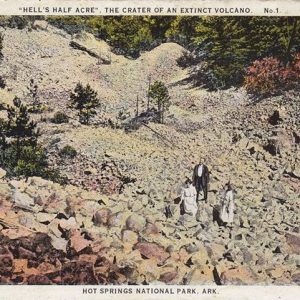calsfoundation@cals.org
Hell's Half Acre
Hell’s Half Acre is a talus hillside (a slope formed by an accumulation of broken rocks) located on Indian Mountain, about four miles northeast of downtown Hot Springs (Garland County). Since the first white settlers arrived in Arkansas, the unique contrast of blighted rock surrounded by otherwise ordinary forest has captured the imaginations of locals. Through the efforts of tourism boosters and storytellers, the area earned its name and its popularized reputation as an area haunted by the Devil himself.
A Hot Springs tourist guide published in 1892 described Hell’s Half Acre as “[a] barren, weird, forbidding conglomeration of boulders, an arsenal for Titans. Not a blade of grass, not a shrub, not even a lichen dares brave the atmosphere of death and desolation which seems to pervade the uncanny spot.” The spiritually minded could draw obvious comparisons to bleak visages of hell as described in the Bible, which makes an intriguing story for anyone intent on creating a tourist attraction. Proponents of the supernatural also told stories of an imprisoned Devil held captive in a crater at the center, “under the crushing weight of innumerable boulders, powerless to do aught but groan and curse his awful fate.” Visitors were said to have encountered the demon’s “sulphurous breath…as it rose from amongst the rocks, and have heard deep underground moans of pain and shrieks of savage profanity.”
Other explanations for Hell’s Half Acre were advanced through the years. At first glance, ancient volcanic activity would seem to explain such an oddity. Some early settlers reached this conclusion, hypothesizing that the crater of an extinct volcano could easily be found near so much geothermal activity in Hot Springs. The rocks at Hell’s Half Acre are not of volcanic origin, however, and the local springs are not heated by volcanic activity, but instead by a process called geothermal gradient.
Archaeological inspection and a knowledge of geology reveal the true origin of the rocks covering the hillside. They are novaculite—an erosion-resistant variety of chert that may be found exposed on hills and ridges throughout the Ouachita Mountains. Ancient Native Americans first began quarrying novaculite around 7,000 years ago, as the material was exceedingly useful in crafting arrowheads, knives, and a wide variety of farming tools. The preforms, blanks, rejected cores, and other debris covering Hell’s Half Acre attest to the impressive amount of work put in by these prehistoric peoples, who mined novaculite sources such as these for over 5,000 years.
Another legend involves the origin of a conspicuous hole at the center of Hell’s Half Acre, identified in local folklore as the same hole that held the captive demon. The legend says that Spanish adventurers once fervently searched this site for gold, but after exhausting themselves digging out a tunnel and breaking up surface rocks, they grew disillusioned and abandoned their search. This small excavation was certainly dug by modern hands (as the rocks in and around this hole are precisely cut and stacked, worked by tools unavailable to prehistoric peoples), but there is absolutely no evidence that the Spanish ever dug here. The legend was likely created to provide additional romanticized back story for tourists. The hole was accessible up until the mid-twentieth century but has since become blocked off by boulders and natural debris.
Hell’s Half Acre is currently located on private property; there is no longer any trail or direct accessibility to it.
For additional information:
Durand, Hubert. Hot Springs, Arkansas: Its Hotels, Baths, Resorts and Beautiful Scenery. St. Louis, MO: Woodward & Tiernan Printing Co., 1892. Online at https://archive.org/details/hotspringsarkans00dura (accessed February 25, 2021).
Marshall, Byron G. “Hell’s Half Acre.” The Record 25 (1984): 31–46a.
Purdue, A. H., and H. D. Miser. “Hot Springs Folio, Arkansas.” Geographic Atlas of the United States Folio GF-215. Washington DC: U.S. Geological Survey, 1923. Online at http://pubs.er.usgs.gov/publication/gf215 (accessed February 25, 2021).
Adam Miller
Austin, Texas
 Hell's Half Acre
Hell's Half Acre 




I have been here recently. Do not go here!
I started at the top. It took me forty-five minutes to bushwhack down to it. It took me three hours to crawl out. I crawled out on my hands and knees. This is by far the hardest hike I have ever made! I am a yoga teacher and am a strong hiker. I usually hike with a water bottle, but I thought, oh it’s just a half mile down the hill, no biggie. Always bring water! Always! Especially if you’re going to face the Devil.
I live in Hot Springs, Arkansas, and I have been to Hell’s Half Acre. It is a sight to see, but not a good one. I’m telling you, there’s an evil about it, and there is an evil about this town. It might sound crazy, but I’ve felt it. I’ve seen it. I have some information about the place and the surrounding area, and it is absolutely bone chilling. Let me put it this way… I plan on moving very soon not because of Hell’s Half Acre specifically, but, like I said, the whole town is like nothing I’ve ever seen. It’s just a terrible place, really. I’ve even thought about making a documentary about this town. Nevertheless, great article.
I live beside Hell’s Half Acre. I was raised not far from the area, and I was always scared of the story my dad told us. Many weird things have happened in our area since it has been disturbed by unwanted attention to the land. It’s a shame because there is a reason to let sleeping dogs lie and be left alone. It’s like opening Pandora box. Then what’s going to happen?